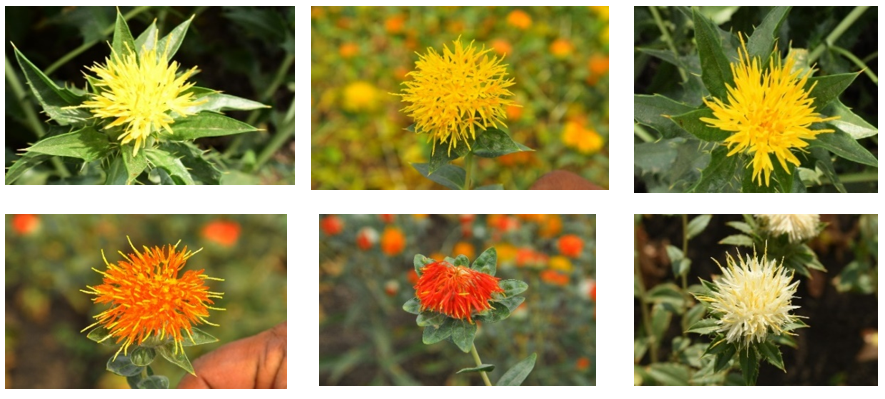Safflower Petal Tea
Safflower Petal Tea
Safflower (Carthamus tinctorius L) is an annual flowering plant with a rich history of cultivation spanning over 4,000 years. It is primarily grown for its edible oilseed, which is renowned for its high linoleic acid content, making it a healthy cooking oil that can aid in reducing blood cholesterol levels. Although the crop has both spiny and non-spiny types, the major cultivated varieties are spiny in nature.
Nutritive value of safflower flowers
 The flowers come in vibrant colors like bright yellow, white, orange, and red. The petals of these flowers contain approximately 4.7% moisture, 1.82% protein, 4.8% fats, 11.6% crude fiber, and 10.8% ash. For centuries, traditional Ayurvedic medicines have included safflower florets in their formulas. Rekindled interest in safflower cultivation has also resulted from new discoveries made in China that have revealed the flowers' therapeutic qualities. Additionally, safflower dye has been employed as a flavoring and coloring agent in Italian, French, and British cuisines. The applications of safflower petals are diverse, ranging from their use as a dye, coloring agent, flavoring, to their inclusion in various concoctions and potions.
The flowers come in vibrant colors like bright yellow, white, orange, and red. The petals of these flowers contain approximately 4.7% moisture, 1.82% protein, 4.8% fats, 11.6% crude fiber, and 10.8% ash. For centuries, traditional Ayurvedic medicines have included safflower florets in their formulas. Rekindled interest in safflower cultivation has also resulted from new discoveries made in China that have revealed the flowers' therapeutic qualities. Additionally, safflower dye has been employed as a flavoring and coloring agent in Italian, French, and British cuisines. The applications of safflower petals are diverse, ranging from their use as a dye, coloring agent, flavoring, to their inclusion in various concoctions and potions.
Safflower flowers are valued for their medicinal qualities; they are said to increase energy, calm down, and control menstrual flow. They may, however, have laxative effects when taken in excess. Safflower flowers contain hydroxysafflor yellow A, an antioxidant that helps cells resist oxidative stress. Numerous clinical and laboratory studies have demonstrated that safflower flower methanol extracts, which are high in flavonoids and phenolic compounds, can reduce the symptoms of pancreatic dysfunction. These studies have demonstrated the efficacy of safflower-based therapies for heart problems, menstrual problems, and post-injury pain and inflammation (Nadkarni, 1976).
Safflower petal tea
Antioxidants abound in safflower petal tea, as research conducted in 1993 by Dajue and Zhou showed. The main benefits of the tea are that it dilates the arteries in the heart and femur, lowers blood pressure, eases blood spasms, and encourages blood vessels to relax. These actions improve blood flow and raise oxygen levels in bodily tissues while inhibiting the formation of thrombus.
Safflower petal tea has several advantages, including the potential to help with weight management, enhance cognitive function, lower the risk of heart disease, and provide cancer protection. Herbal teas contain compounds that can reduce the body's production of free radicals, protecting molecules and cells from harm. These free radicals have been linked to a number of diseases and the aging process.
Safflower tea preparation
For safflower tea, you'll need pure dried petals and hot water. Start by bringing fresh water to a boil, then steep one teaspoon of dried safflower petals in a cup of hot water for approximately 5 minutes. Afterward, strain and serve. This tea is best enjoyed without any additional condiments, but a touch of honey, about a teaspoon, complements it nicely. You have the option to serve it either hot or chilled, as both variations are equally delightful.
Safflower tea blends harmoniously with
- Chamomile: Another soothing flower tea with a sweet flavor.
- Orange: Experiment by brewing it with fresh or dried orange slices.
- Green tea: Although safflower tea is milder, it complements slightly stronger green teas.
Reference
- Nadkarni, A. K., 1976, Indian Materia Medica. Popular Prakashan, Bombay, 1 (3): 296
- Li Dajue and Hans-Henning Mündel. 1996. Safflower. Carthamus tinctorius L. Pro-moting the conservation and use of underutilized and neglected crops. 7. Instituteof Plant Genetics and Crop Plant Research, Gatersleben/International Plant GeneticResources Institute, Rome, Italy
Contributors
Pushpa H.D, Usha Kiran B, Helan Baby Thomas, Anil Kumar A, Jawahar Lal J and P. Madhuri
ICAR-Indian Institute of Oilseeds Research (ICAR-IIOR), Rajendranagar, Hyderabad-500 030, Telangana, India
Last Modified : 11/13/2023
Provides information about the health benefits of ...
